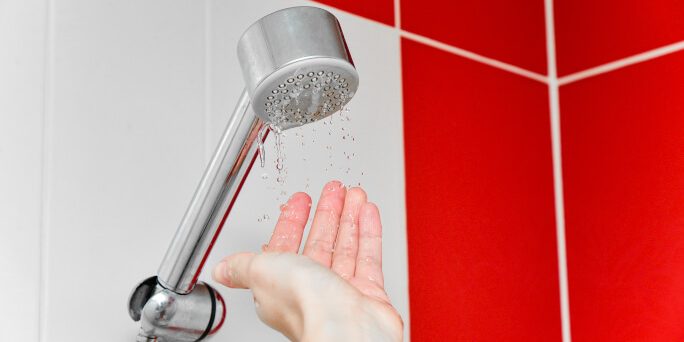We understand how agonising it is for you to experience inappropriate water pressure in your kitchen, bathroom or even in the garden. Pressure issues are indicative of the faults in your premises’ plumbing system, and this should be addressed asap. You should also keep a proper eye on and check the water pressure in your home on a regular basis. If there is any irregularity, you might require expert plumbing services. In this blog, we have covered all your common queries related to water pressure in London. Here is a quick view of the sections of the blog:
- What is water pressure?
- How to check water pressure?
- How do we measure water pressure?
- Reasons behind low water pressure in homes?
- How do we increase water pressure in a property?
What Is Water Pressure?
Water pressure is the force with which the water flows through the pipes in your home to the taps and showers. It is measured in terms of bars and pounds per square inch (psi). Low water pressure means more time will be taken for water to fill your bathtub or sink. The situation worsens when your residence is located on higher floors, as the water needs to travel against gravity to meet your requirements. In case of high-water pressure, the probability of deteriorating the health of your plumbing system increases, as water comes out at high speed from your taps and showers. An ideal water pressure should not be over 60 psi.
A simpler way to understand this is in terms of the rate of water flow in your pipe. If the water flow is 15 litres per minute, you have an appropriate water pressure. However, anything in between 10-15 litres per minute is also acceptable.
How To Check Water Pressure?
Now that you know the ideal water pressure numbers, it’s time to learn how to check the water pressure at your residence.
Equipment Needed For Water Pressure Test
- A measuring jug (one to two litres)
- A timer
- A calculator
- A water pressure gauge (for high-pressure check)
Check For Low Water Pressure
- Turn on the tap and place the measuring jug under it.
- Switch on the timer
- Record the time taken to fill with water up to the 1 litre mark
- Ideally, if you are required to spend more than 6 seconds to fill up to 1 litre of water, you have low water pressure.
Check For High Water Pressure
- Ensure all the taps inside and outside your home are fully turned off.
- Attach a water pressure gauge on one of the outside taps.
- Open this tap to its full potential.
- Note the reading on the gauge. An ideal value is 40 psi to 60 psi.
- If the reading goes above 60 psi, it’s time to call the plumbing expert. A value below 40 is indicative of leaks somewhere.
Here are a few signs indicative of high-water pressure at your home:
- Banging water pipes.
- Continuous flow of water in toilets without any obvious visible reason.
- Dripping taps even when tightly closed.
- Running out of hot water much before the estimated time.
Check For Shower Flow Rate
- Make use of a wide-mouth jug (as big as your shower head) or any other vessel that can indicate the amount of water collected.
- Turn on the tap and place the measuring jug/vessel under your shower head
- Switch on the timer.
- Record the time taken to fill water up to 1 litre mark.
- Ideally, if you are required to spend more than 6 seconds to fill up to 1 litre of water, you have low water pressure.
What Are The Reasons Behind Low Water Pressure In Homes?
Demand>Supply
When the need for water in your area at a specific time is at mass level, the water pressure in every household obviously drops beyond the normal value. Suppose almost all the households in your area seek showers at a particular time; the supply will get evenly distributed amongst all, and as a result, the general water pressure in the area will be reduced.
Vintage Narrow Pipes
Older homes have narrower pipes than those newly constructed ones. Water flows at a slower speed in these narrow pipes compared to the wider modern pipe systems.
Pipe Blockage
Due to the frequent flow of water in pipes, there tends to be unwanted accumulation of limescale, dirt, rust, etc. that further narrow down the space for water flow, thus lowering the water flow pressure.
Clogged Tap Head
Like the inner lining of the pipes, limescale, dust, and rust also clog the shower head, tap outlet head or the outlet of any appliance. As a result, although the flow of water inside the pipe is normal, the water pressure that exhibits the water from the tap or shower is low.
Head Of Water
The head of water refers to the height between the tank water level and the shower head. This height should ideally be at least 1 metre to enjoy good water pressure in your shower.
Obstructed Stopcock Or Valve
If any sort of debris gets stuck in the stopcock or valve, the water pressure will automatically lower. So, keep a regular check on its cleanliness below your kitchen sink.
In situations where the water pressure is obstructed because of the deposition of limescale, dirt, rust, or debris, make use of vinegar and baking soda to clean the area and enjoy perfection. You may also use a supplement to strengthen the flow of water in your shower by using a shower pump or replacing the existing shower head with a power shower. After making all the efforts at your DIY level, if you still need professional guidance, or any sort of plumbing emergency services, be ready to call the experts of plumbing systems in your vicinity.


